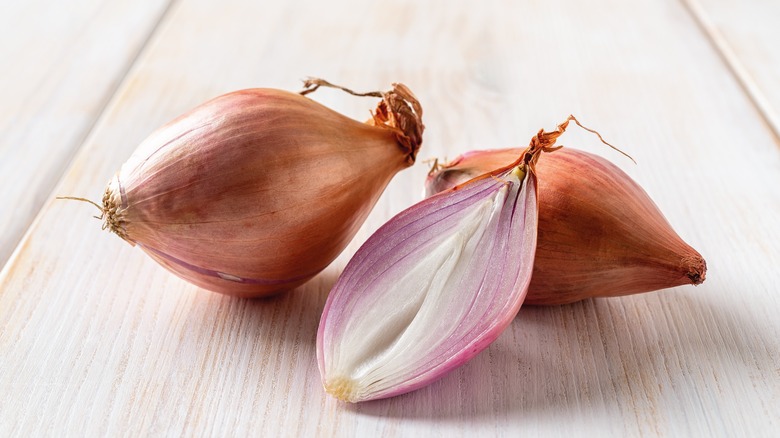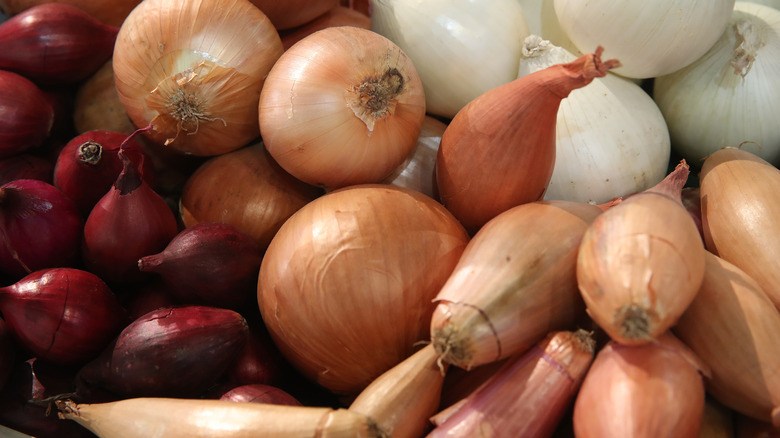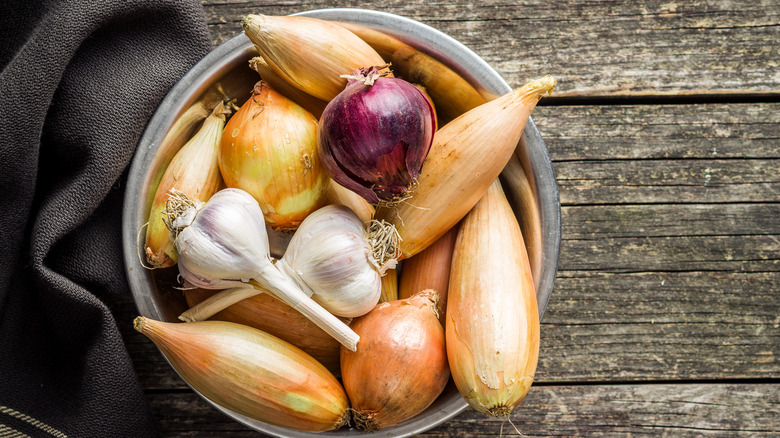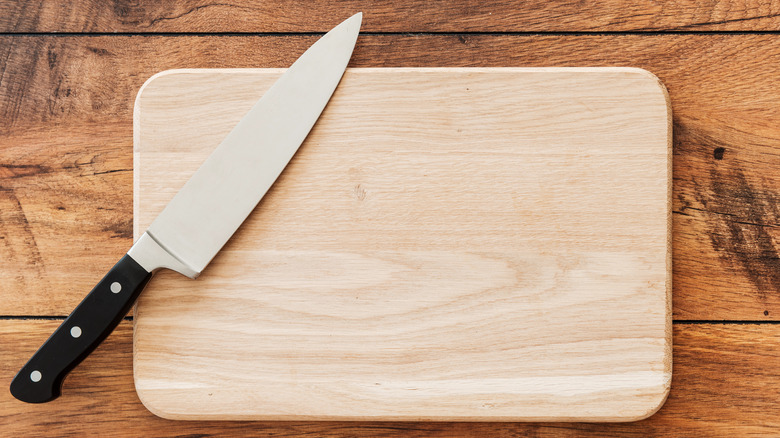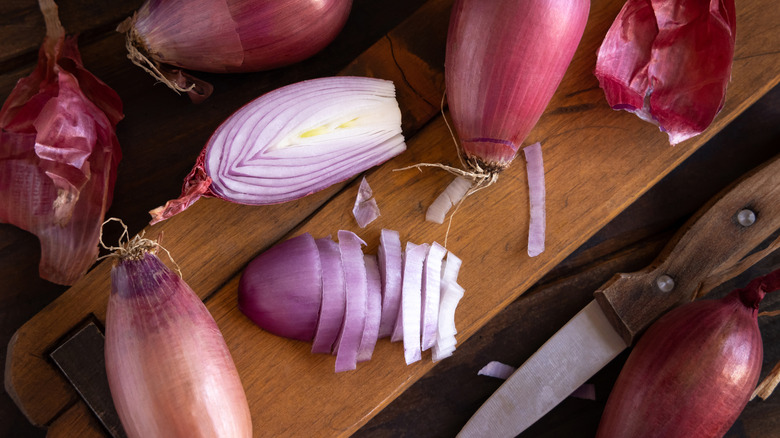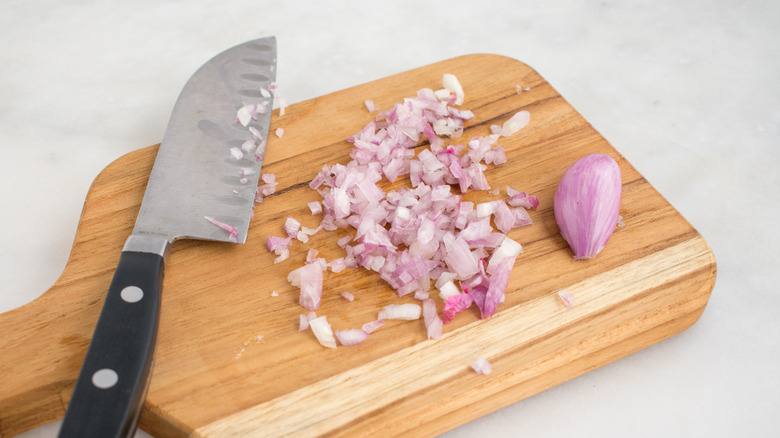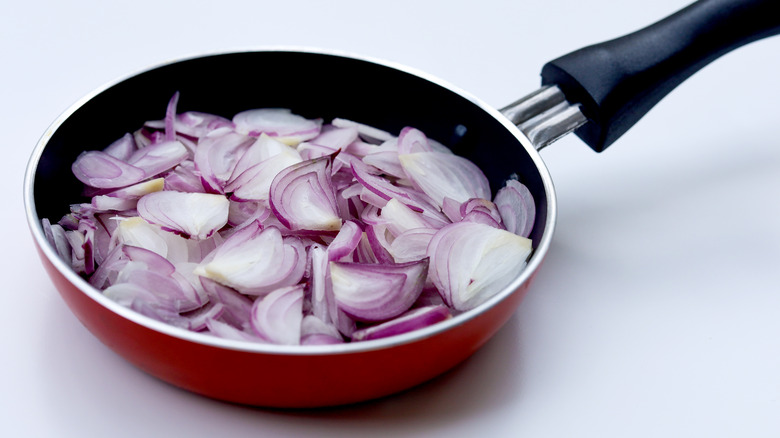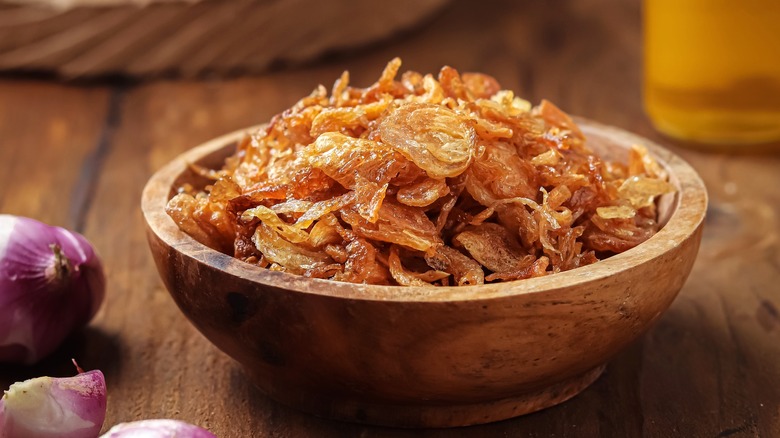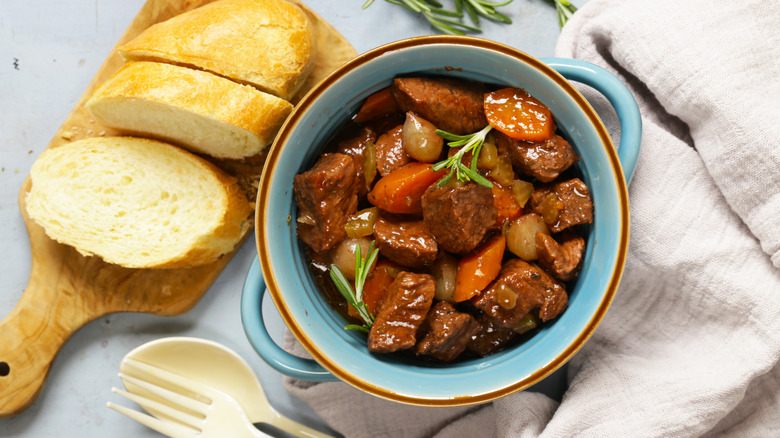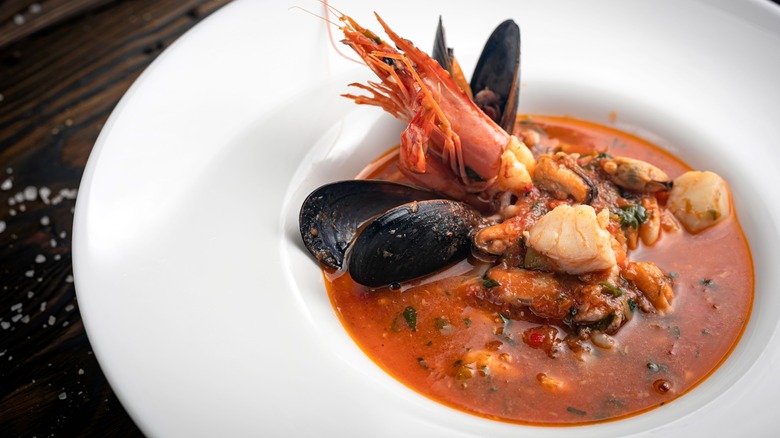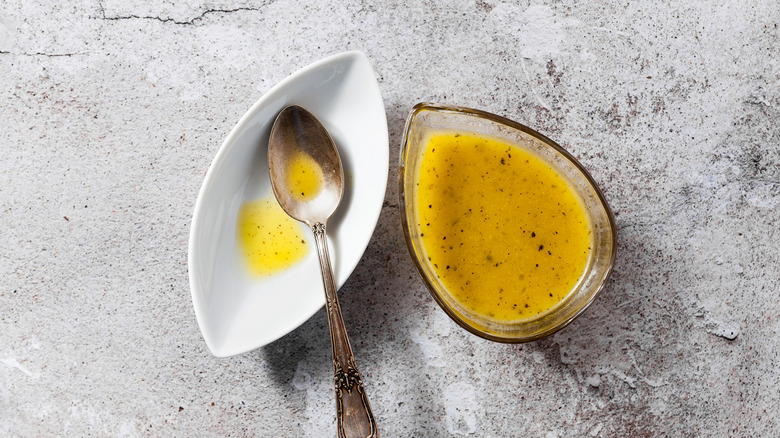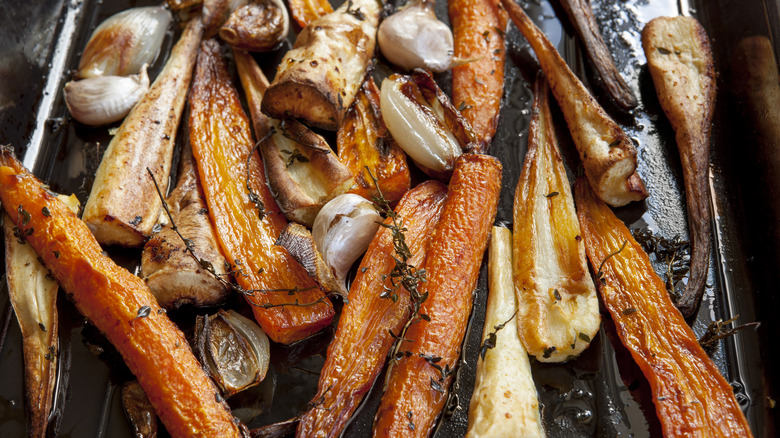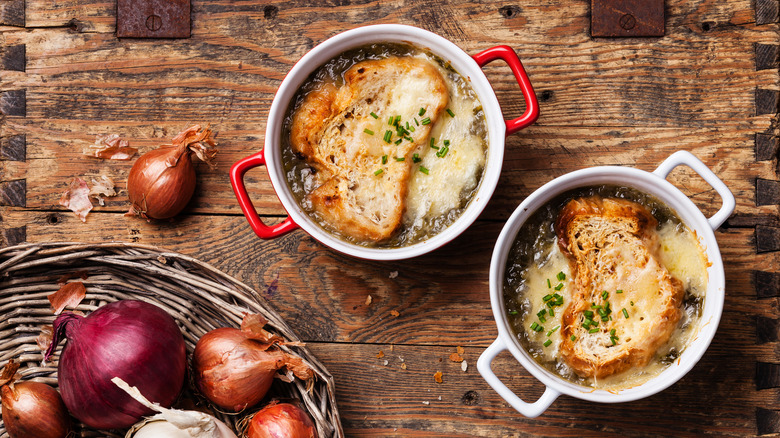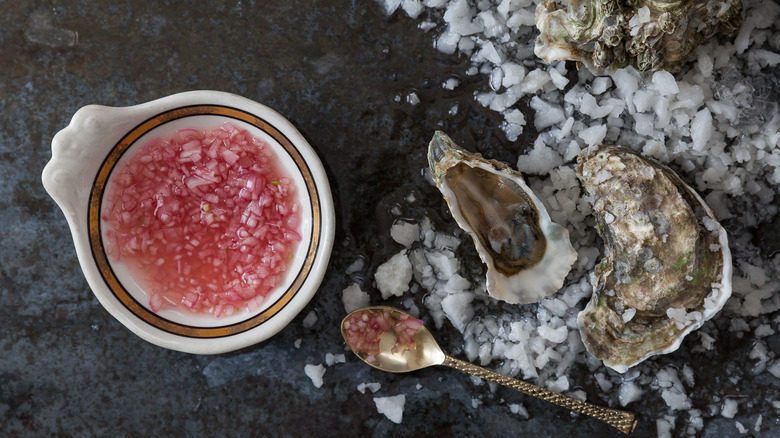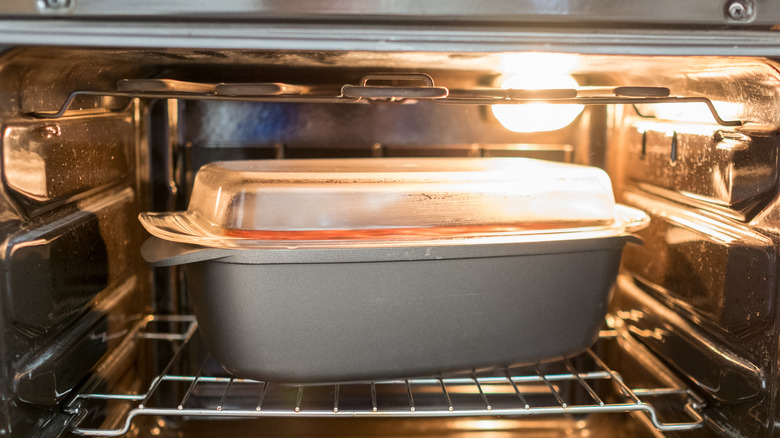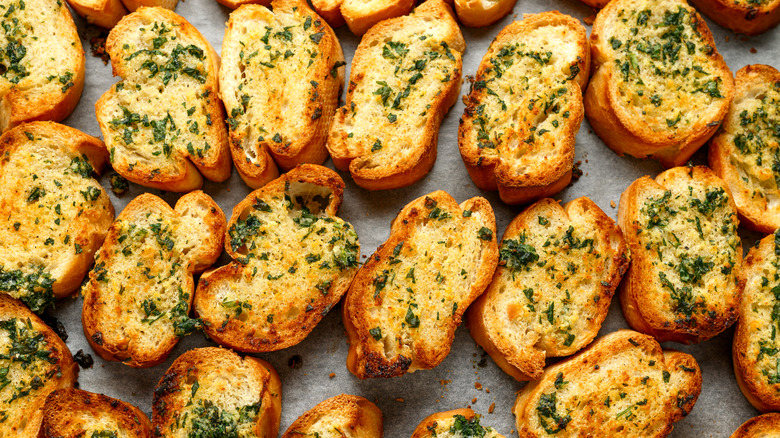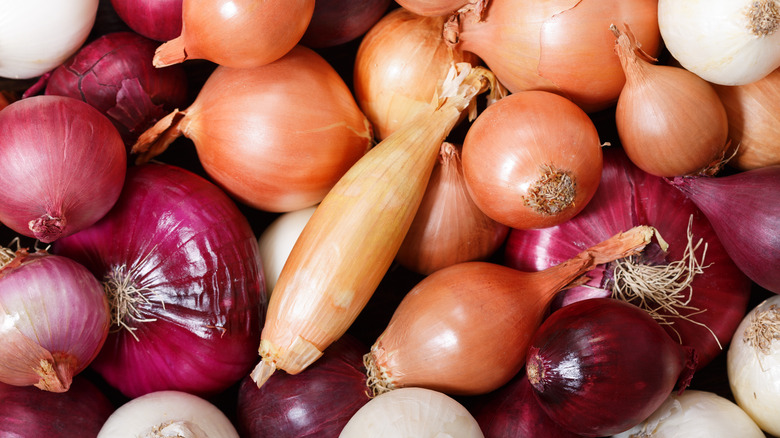15 Tips You Need When Cooking With Shallots
If you're ready to think outside of basics and experiment with unique ingredients, then it's time to start incorporating more shallots in your everyday cooking. They are onion's sweeter, milder cousin that comes in a much smaller package. In fact, shallots even look like small, oddly shaped onions and come in a variety of colors. Shallots are quite delicate in both texture and flavor and can be enjoyed in a variety of ways. However, if you're new to using them in your cooking, stick to some basic tips you need when cooking with shallots to allow them to reach their full potential.
Shallots are a fragrant aromatic that can be enjoyed both raw or cooked. Originally from Southeast Asia, the bulb has exploded in popularity around the world and has especially made an impression in Mediterranean and French cuisine. Head to your local market, grab a few of these little root vegetables and let's get cooking.
Select the right variety
Once you fully understand what you're getting yourself into when it comes to the flavors and textures of shallots, it's time to narrow down which variety will work best with your recipe. It may seem surprising that shallots come in several varieties because your typical grocery store generally carries prisma shallots, which are deep pink, glossy, and slightly elongated.
Beyond prisma shallots, there are two other main varieties of shallots that you should know about. Grey shallots are often a top pick for chefs and are distinctive for their elongated shape and greyish-purple skin. They are often preferable because of their stronger flavoring and are sometimes referred to as Griselle shallots. Pink shallots are rounder than prisma shallots. Their outer layer may look a bit more like a light rust color, but once the papery exterior is shed, the first edible layer will be light purply pink. They are often referred to as jersey shallots and are slightly larger than other types. They are quite versatile because they are less bitey than other varieties and can be used raw. Whichever variety you choose, give it a squeeze to be sure the bulb is firm before buying.
Store them properly
Produce, in general, can be confusing to store properly. Should you keep leafy greens in their bags? Soak carrots in water? Store potatoes in the refrigerator? Set fresh herbs in a jar with water? And what the heck is a crisper even for?! When it comes to shallots and other root vegetables, storage is quite simple. They aren't fussy like kale or avocados, so leaving them at room temperature will be just fine for several weeks. If you have a basket or produce bowl on your kitchen counter, pop them in there. Avoid storing them with potatoes because the gases in the onion cause potatoes to sprout prematurely.
To elongate the lifespan of your shallots, store them in the refrigerator. Many people opt to store their root vegetables in their cellars or basements, especially in the summer when their kitchens are warm and humid. If you notice mold forming on your shallots, a strong rotten smell, or you feel that it has become soft is leaking fluid, then it's time to throw them out and consider a cooler, dryer storage space.
Peel them effortlessly
Although the papery skin on shallots can be quite beautiful, you don't want them ending up in your recipe. They can, however, be saved and added to a delicious, homemade broth. Instead of peeling your shallot with your fingers like a clementine, use a small sharp knife. The sharper, the better; in fact, most accidents happen with dull knives. so don't let a newly sharpened blade scare you. Simply slice off both ends, the roots and the top. Place one of the cut ends on the cutting board, and use your knife to slice a shallow cut from the tip to the base.
At that point, it's best to set your knife down and use your fingers to peel away the papery outer layers. If the first rubbery layer seems tough, remove it as well. You should be left with a slight plasticity, shiny layer that's bright in color. Because shallots are encased by a protective layer, there is no need to wash them once peeled. If you find any powdery green substance on your shallot, then rinse it off.
Choose how you want to slice them
When it comes to slicing shallots, there are many ways to go about it, and it's all dependent on your recipe and desired outcome. Like onions and garlic, shallots are quite intense in flavor but tend to be sweeter and milder. Typically, if you're going to use raw shallots in a dressing, sauce, or mignonette, then it's best to mince them or dice them quite finely. Unlike garlic, you should avoid crushing shallots, as they have a pleasant, onion-like crunch that can be detected even when finely chopped.
If you're planning on making crispy or fried shallots, it's best to cut them into rings. Do this by removing the ends and then cutting crosswise into small strips. The rings will break up naturally when cooked. For recipes calling for sautéed shallots, it's okay to enjoy them in larger pieces, so feel free to cut them into strips, dice them, or slice them into rings.
Enjoy raw or cooked
Although shallots often go overlooked in day-to-day cooking, they are incredibly versatile and can be worked into almost any savory dish. Just like garlic, the more, the merrier because when it comes to flavoring, these little pink root vegetables really know how to pack a punch. And just like other aromatics, they can be enjoyed both raw or cooked. The flavor difference between the two is quite distinctive, so it's important to choose wisely.
Raw shallots have a bitey, sharpness with sweet undertones. They are less intense than onions and sweeter than garlic. In addition, they are firm, so they can be quite crunchy and carry a liquidy burst of flavor when chewed. Once cooked, shallots become incredibly sweet as their natural sugars begin to caramelize. Similar to onions, their flesh becomes soft and tender. As they begin to caramelize, shallots will darken in color and may even become slightly sticky.
Brown shallots gently in oil
As shallots have a delicate sweetness, they are also delicate in form. It's important to cook them properly so they will retain their sweetness and deliver a desirable texture. Although their flavor is strong, they can be slightly finicky when cooked, so it's important to be intentional and keep a close eye on them. Like garlic, shallots can become bitter when overcooked.
Although caramelization and butter seem to go hand in hand, there is a reason you shouldn't only use butter to caramelize onions and shallots. But don't write butter off just yet. Instead, use a combination of butter and oil in your hot stovetop pan. This will help you to avoid burning your shallots because butter has a low smoking point. This way, you get to enjoy the flavor of the butter and the high smoking point from the oil.
Heat the oil on low to medium heat before adding the shallots. Keep them moving to prevent any one part of them from burning, and turn down the heat to low to allow slow caramelization. Remove them from heat a little before you believe they are done because they will continue to cook in the hot oil.
Top entrees with crispy shallots
When you dine out at an upscale restaurant, it's easy to tell that you're about to enjoy incredible food even before it reaches your mouth. Presentation is part of the puzzle, including varying colors and textures. No bite should be monotonous, so garnishes and toppings are so important. They aren't there just to make the plate more beautiful, although they certainly have a tendency to do that as well. A common texture missing from homemade food is the crispy factor.
Crispy or fried shallots are the perfect addition to any savory dish. Not only are they bitey and sweet, but they also can produce the perfect mouthfeel and crunch. And the best part is, you don't need a deep fryer to get the job done. Begin by peeling and slicing your shallot into thin rings. Then, cook them in hot oil over medium to high heat. Once they begin to brown, remove them from the stovetop and let them rest on a paper towel to absorb the excess oil.
Use them to flavor or top proteins.
When you think about it, a plain piece of chicken really isn't anything to write home about, so spices, aromatics, and sauces are needed to give it an unforgettable flavor. That's where shallots come in handy. Quite commonly, they are used to accompany proteins and go beautifully with both land and sea varieties. Shallots are mellow and sweet enough to accompany delicate white fish but punchy enough to elevate a ribeye or gamey rib of lamb.
In fact, there is no protein that doesn't pair well with the brightly colored aromatic and even goes well with vegetable entrees and sides. Consider caramelizing or frying them as a garnish or cooking your protein right in shallots cooked in oil or butter. If you're cooking a thick cut of chicken or steak, add the shallots later in the game so that they don't burn by the time the meat is cooked through. For fish and thin cuts, you're welcome to add them earlier, along with other aromatics. Chefs often choose to make a shallot-based sauce to drizzle over the top of proteins after they've cooked, reducing your risk of burning them.
Use them to make a classic bouillabaisse
French cooking can be quite demanding. Often, the recipes call for extensive ingredients, and it can be rather time-consuming to complete a dish, start to finish. But the result? Unmatched. Shallots, champagne vinegar, loads of butter, and Dijon mustard seem to always make their way into French recipes, and we are here for it. If you've ever attempted to make a classic French bouillabaisse recipe, then you can appreciate the importance of following each step and being sure to include all ingredients. One of the most important ingredients is shallots because they contribute incredibly to the overall flavor and intensity of the broth.
Bouillabaisse originated in Marseille, a port city in France. It consists of a fished-based broth, typically homemade, rouille sauce, crushed together using a mortar and pestle, and fresh fish. It's no wonder this recipe comes from an ocean town. Shallots pair beautifully with fish because they have distinct sweet undertones and are a mild aromatic that won't overpower the subtle flavors of seafood.
Mince and use them in salad dressing
Vinaigrette fans gather around. If you haven't discovered the wonders of a shallot vinaigrette, you're missing out. While a garlic-based dressing can be rather delightful, you also risk overpowering delicate greens with pungent intensity. For a more subtle yet similar flavor, turn to your new best friend, the shallot.
Consider adding minced shallots to your dressing. Even if you rather enjoy a creamy consistency, a green goddess, or even a tomato-based dressing, shallots can bring your salad to a whole new level. Mince them raw, and mix them right into any dressing. Balance with high-quality olive oil, an acid-like champagne vinegar, a sweet element, and a little Dijon mustard. If you're a fan of warm salads, try slightly cooking the shallots before adding them to the warm dressing or topping your salad. Shallots can enhance any salad, from those with roasted nuts and fresh fruit to a loaded cob.
Roast whole shallots
Arguably, any vegetable can be enhanced when slow-roasted in the oven. Red pepper becomes tender and sweet, sweet potato crisps up, and mushrooms become juicy and flavorful. There are no exceptions when it comes to shallots. Whole shallots should be slow-roasted until tender and sweet. Simply peel your shallots, trim off the ends, coat in olive oil, and roast in the oven at 400 degrees Fahrenheit for about one hour. This should produce soft bulbs that are so sweet they can be enjoyed on their own. For a softer shallot, leave the papery outer layer on and remove it once the root veggies are cooking.
Roasted shallots make an incredible addition to any stew and can also be blended into soups and bisques. They pair exceptionally well with roasted carrots and thyme and can be a beautiful addition to roasted lamb or tender beef.
Elevate French onion soup
French onion soup may take quite a bit of time to make, but slow roasting those onions is well worth the effort. The caramelized goodness and slow release of sugars in the rich buttery beef broth is enough to make anyone drool. Wipe off your chin and prepare yourself for an enhanced version of this classic. In addition to sweet onions, include shallots.
Use your favorite French onion soup recipe, but mid-way through simmering those chopped onions, add shallots to the mix. This doesn't mean you need to remove onions from the recipe altogether; it is called French onion soup. Replace one onion with enough shallots to cover the same volume, about four or so, depending on the size. This version is much sweeter than the original and includes a slight garlicky nip. Don't expect the recipe to taste wildly different, but there will be a distinction that your guests or family may not be able to put their finger on.
Enjoy shallots with raw oysters
When it comes to raw shallots, they are perhaps most recognized for their pairing with raw oysters in the form of a shallot mignonette. For those of you who have avoided the famous gooey seafood blobs that come encased in their own shells, it may be time to close your eyes and give them a try. Although oysters may not be the most beautiful food on the planet, their salty, tender, subtle flavor is quite desirable to those open-minded enough to try them. Some enjoy their oysters with a cocktail sauce, others with lemon juice, some plain, but for many, nothing is better on freshly opened oysters than a mignonette sauce.
A classic shallot mignonette recipe for oysters typically includes a base of white wine or champagne vinegar, along with minced shallots, black pepper, tarragon, and salt. It helps to enhance and highlight the briny, sweet flavors of the oyster without overpowering it. For anyone ready to try oysters for the first time, consider pairing them with a sweet and bitey shallot mignonette.
Make shallot confit
Garlic confit is all the rage, and how could it not be? Bitey, sweet, garlicky goodness, slow-cooked in olive oil until tender and spreadable. Well, if garlic confit is on your radar, it's time to meet your new favorite, shallot confit. It's sweet, soft, and spreadable, just like butter. In fact, mashed and mixed with butter, it's the ultimate spread for sandwiches, crackers, or a French baguette.
Start by peeling your shallots and then packing them tightly into an oven-safe dish. Submerge with olive oil, and add fresh herbs if you feel so inclined. Cook in a preheated oven at 325 degrees Fahrenheit for about 90 minutes to two and a half hours. You'll want the shallots to become soft, so pierce them with a butter knife to tell if they are cooked enough. Overcooked shallots will become tough, so finding that sweet spot in between is important.
Elevate garlic bread
There is a lot of turmoil in the world and division in the U.S., but there is something that just about everyone can agree upon: Garlic bread is amazing. There's just something about that crispy, crunchy outer layer, and pillowy soft inside coupled with a melted, smooth, buttery garlic spread topped with freshly minced parsley. It's the ultimate comfort food, but for decades it's been missing one essential ingredient.
The roasted ingredient that will level up garlic bread is shallots, and they add a sweetness that garlic and oil just can't seem to touch. Roast them just like you would garlic by cutting off the ends and filling the layers and folds with olive oil. Heat in the oven until tender, and use heat-protective gloves to squeeze them out of their skins. Along with garlic, olive oil, and butter, spread the roasted bulb right on the bread. For best results, use a high-quality baguette and fresh parsley and finish with cracked black pepper and coarse sea salt.
Use in place of onions
Don't get us wrong; onions are delicious. There is an incredible variety out there that covers all the bases. If you enjoy sweet onions and wish you could go even sweeter, then it's time to consider substituting onion with shallots. The key is to replace your onion with the correct amount of shallots. Although it may be tempting to swap a bulb for a bulb, it's important to go by volume. That means if your recipe calls for one cup of chopped onion, use one cup of chopped shallots.
This swap can be applied to any recipe in your book. That includes your morning omelet, a simple stir fry, minced into meatballs, or even layered on a loaded burger. If you're unsure about jumping in full turkey, start by using a 50:50 ratio of onions to shallots. Expect a sweeter, more mild flavor with that same subtle nip that sweet onions hold, along with a more delicate texture.
Static Media owns and operates The Daily Meal
